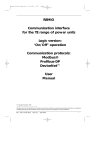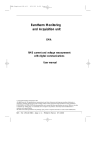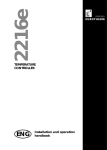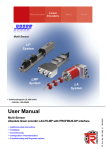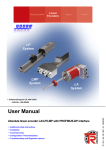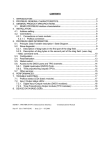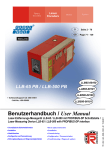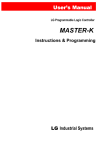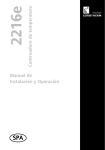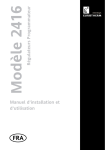Download REMIO User manual TPO version issue 2.2
Transcript
REMIO/TPO/ENG.A5 6/11/00 8:42 Page 1 REMIO Communicating interface for the TE range of power units TPO Version: Time Proportioning Output Communications protocols Modbus® Profibus-DP DeviceNet™ User Manual © Copyright Eurotherm Automation 1998 All rights reserved. All reproduction or transmission in any form or using any procedure (electronic or mechanical,including photocopying or recording) without written authorisation from EUROTHERM is strictly prohibited. Part No. HA 175874 ENG - Issue 2.2 - Printed in France 10/2000 i REMIO/TPO/ENG.A5 6/11/00 8:42 Page 2 CONTENTS Relevant European Directives Chapter 1 Identifying The Interface . . . . . . . . .1-1 Chapter 2 Wiring . . . . . . . . . . . . . . . . . . . . . . . . .2-1 Chapter 3 Digital Communications . . . . . . . . . .3-1 Chapter 4 Configuration . . . . . . . . . . . . . . . . . . .4-1 Chapter 5 Operation . . . . . . . . . . . . . . . . . . . . . .5-1 ii REMIO/TPO User Manuel REMIO/TPO/ENG.A5 6/11/00 8:42 Page 3 RELEVANT EUROPEAN DIRECTIVES SAFETY REMIO products are not affected by the European Low Voltage Directive of 73/23/EEC of 19/2/73 (amended by the Directive 93/68/EEC of 22/7/93). ELECTROMAGNETIC COMPATIBILITY (EMC) (For industrial environments only, must not be used in domestic environments) Eurotherm certifies that REMIO products, installed and used in compliance with this User Manual, meet the following EMC test standards and enable the system which incorporates them to comply with the EMC Directive, as far as the REMIO products are concerned. EMC test standards Immunity Emission Generic standard: Test standards: EN50082-2 EN 61000-4-2, EN 61000-4-4, EN 61000-4-3, EN 61000-4-6, ENV 50204 Generic standard: EN 50081-2 Radiated: EN 55011 Class A EMC Guide In order to help you reduce the effects of electromagnetic interference depending on the product installation, Eurotherm can supply you with the 'Electromagnetic Compatibility' Installation Guide (part no. HA 025464 ENG). This guide lists the rules generally applicable for EMC. VALIDATION BY INDEPENDENT BODY Eurotherm has validated the compliance of REMIO products with EMC test standards through product design and laboratory testing. REMIO/TPO User Manuel iii REMIO/TPO/ENG.A5 6/11/00 8:42 Page 4 Personnel The installation, configuration, commissioning and maintenance of the REMIO interface must only be carried out by personnel qualified and trained to work with low voltage electrical equipment in an industrial environment. Independent alarm Given the safety regulations concerning personnel and property, and the value of the equipment controlled by REMIO and the power units, we recommend the use of independent safety devices (alarms), which should be tested regularly. Eurotherm can supply various types of alarm device for this purpose. Further information For any further information, or if in doubt, please contact Eurotherm Controls where qualified staff are available to advise or assist you with the commissioning of your installation. iv REMIO/TPO User Manuel REMIO/TPO/ENG.A5 6/11/00 8:42 Page 5 Identifying the unit Chapter 1 IDENTIFYING THE REMIO INTERFACE Contents Page General introduction.................................................................................1-2 Front panel of unit....................................................................................1-4 Technical specification...............................................................................1-7 Product code............................................................................................1-9 Example of product code........................................................................1-10 Identification label..................................................................................1-10 REMIO/TPO User Manuel 1-1 REMIO/TPO/ENG.A5 6/11/00 8:42 Page 6 Identifying the unit Chapter 1 IDENTIFYING THE INTERFACE GENERAL INTRODUCTION The REMIO communications interface is designed to control several power units from the TE range via the digital communications bus. This User Manual describes the use of the TPO version of REMIO interfaces, with three communications protocols: Modbus®, Profibus-DP, DeviceNet™ The REMIO/TPO interface receives setpoints via the communications bus and transmits them to the power units which it controls, in the form of a modulated logic output signal. REMIO is a modular product, comprising: • a Base Module and • two Optional Modules (Expansion Modules). The Base Module pr ovides communications bus and power supply connections and the necessary configurations. In the TPO version, each module (the Base Module as well as the Expansion Modules) comprises 16 outputs, designed to transmit the setpoints received by the communications bus to the power units in the form of a logic output signal with dual-mode time proportioning (TPO). The maximum output count for the REMIO is 48. REMIO TPO modules allow the use of two power unit firing modes, depending on the power supply used: • Fast cycling with a 24Vdc power supply • Advanced Single-cycle with a 24Vac supply. The LEDs on the REMIO front panel show the state of the communications bus and of the module power supply. REMIO is mounted on a symmetrical DIN rail. Detailed operation of the communications bus is described in the following manuals: • REMIO/Modbus® Communications Manual (part no. HA 175814 ENG) • REMIO/Profibus-DP Communications Manual (part no. HA 176078 ENG) • REMIO/DeviceNet™ Communications Manual (part no. HA 176272 ENG) Operation of the power units controlled is described in the User Manuals: • TE10S/DC (part no. HA174780 ENG) • TE10S/PLF (part no. HA174784 ENG) • TE200S (part no. HA175921 ENG) • TE300 (part no. HA175437 ENG) 1-2 REMIO/TPO User Manuel REMIO/TPO/ENG.A5 6/11/00 8:42 Page 7 Identifying the unit Figure 1-1 Overview of REMIO/TPO Base Module (Modbus® protocol) REMIO/TPO User Manuel 1-3 REMIO/TPO/ENG.A5 6/11/00 8:42 Page 8 Identifying the unit FRONT PANEL OF UNIT The following diagrams show: • the front panels of the REMIO/TPO unit in various physical configurations - without optional modules: Base Module version - with optional modules (maximum configuration) • the front panel labels which correspond to each protocol. Figure 1-2 Front panel of REMIO/TPO (Profibus-DP protocol) in Base Module version 1-4 REMIO/TPO User Manuel REMIO/TPO/ENG.A5 6/11/00 8:42 Page 9 Identifying the unit Figure 1-3A REMIO/TPO Base Module label in Modbus® protocol Figure 1-3B REMIO/TPO Base Module label in DeviceNet™ protocol Figure 1-3C REMIO/TPO Base Module label in Profibus-DP protocol REMIO/TPO User Manuel 1-5 REMIO/TPO/ENG.A5 6/11/00 8:42 Page 10 Identifying the unit Figure 1-4 Front panel of REMIO/TPO (Modbus® protocol) in maximum configuration (48 outputs) 1-6 REMIO/TPO User Manuel REMIO/TPO/ENG.A5 6/11/00 8:42 Page 11 Identifying the unit TECHNICAL SPECIFICATION The REMIO communications interface is designed to drive various thyristor power units controlling resistive industrial loads and short-wave infrared elements. Hardware configuration Base Module Expansions 1 or 2 2 ports each with 8 outputs providing dual-mode time proportioning logic output signals (TPO). - Configuration mini-switches - Power supply connector - Communications bus connector 2 ports each with 8 outputs providing dual-mode time proportioning logic output signals (TPO). Port specification TPO outputs Common excitation potential Resolution Connectors Voltage 20V, modulated Time proportioning from 0 to 100% Maximum current limited to 6.5mA Possible to connect two solid state relay (SSR) inputs from the TE range in series on each TPO output For all TPO outputs a common +20Vdc supply is available on each port. 8 bits (0.4%) Plug-in, M3 screws Communications Communications protocol Bus Transmission baud rate Modbus or Profibus-DP or DeviceNet™ (specify when ordering) 2-wire Standard RS485 (Modbus® or Profibus-DP) or CAN Bus (DeviceNet™) Modbus: 9.6k or 19.2kbaud (configurable) Profibus-DP: auto Baud rate detection up to 1.5Mbaud DeviceNet™: 125k, 250k or 500kbaud (configurable) Diagnostics Communications LED indication State of communications bus State of REMIO and of TPO outputs Bus state, REMIO state (DeviceNet) Module power supply Power supply Voltage Consumption REMIO/TPO User Manuel 24Vdc non-polarised (-15%, +25%) or 24Vac (-15%, +10%), 47 - 63 Hz Depends on number of outputs used (20VA max) 1-7 REMIO/TPO/ENG.A5 6/11/00 8:42 Page 12 Identifying the unit Thyristor firing General All base module and optional module outputs are modulated in the same way: Burst-firing or Intelligent Single-cycle By type of supply volta ge DC supply voltage (24Vdc): Burst-firing Number of firing or non-firing cycles at 50% setpoint: 8 cycles AC supply voltage (24Vac): Intelligent Single-cycle Firing or non-firing by a complete number of half-cycles DC component absent Firing starts and ends at zero voltage Selection Firing modes Switching Environment Operating temperature Storage temperature Power supply circuit protection External wiring Operating atmosphere Humidity Pollution 0°C to +45°C at 2000m max. altitude -10°C to +70°C External 2A fuse To be carried out in accordance with Standard IEC 364 Non-explosive, non-corrosive & non-conductive RH: 5% to 95%, non-condensing and non-streaming Pollution degree 2 permissible, defined by IEC 664 Physical dimensions Dimensions (mm) Mass (kg) Height: 115 (122: including connectors) Depth: 92.5 Width: Base module = 87.5 One Optional Module = 17.5 Maximum configuration = 122.5 0.9 (maximum configuration) Warning! EUROTHERM has made every effort to ensure that the specification g iven in this manual is as accurate and up to the minute as possible. Ho wever, in order to maintain our 'leading edge',it may be necessary to make certain changes or omissions to our specification. We cannot be held responsible for any dama ge to persons or property or for any financial loss or costs arising from this. 1-8 REMIO/TPO User Manuel REMIO/TPO/ENG.A5 6/11/00 8:42 Page 13 Identifying the unit PRODUCT CODE REMIO / Base Module / Exp.1 / Exp.2 / Protocol / Transmission rate / Manual // 00 Base Module Code 16 dual-mode* time-proportioned outputs TP Expansion Module 1 Code Expansion 1 provides (16 dual-mode* time-proportioned outputs) Without Expansion 1 TP - Expansion Module 2 Code Expansion 2 provides (16 dual-mode* time-proportioned outputs) Without Expansion 1 or 2 TP - Communications protocol Code Modbus® Profibus-DP DeviceNet™ MOP PFP DNP Transmission rate Code Modbus® : 96 192 AUTO 125 250 500 Profibus-DP : DeviceNet™ : 9.6kbaud 19.2kbaud (auto Baud rate detection) 125kbaud 250kbaud 500kbaud Manual language Code French English FRA ENG *) The firing mode of TPO module outputs is determined by the power supply type: 24Vac = Advanced Single-cycle; 24Vdc = Fast Cycling REMIO/TPO User Manuel 1-9 REMIO/TPO/ENG.A5 6/11/00 8:42 Page 14 Identifying the unit EXAMPLE OF PRODUCT CODE Example 1 Number of TE10S solid state relays (SSRs) controlled by REMIO : 15 (15 < 16 = without Expansion Modules) Communications used: Modbus® at 9.6kbaud Firing mode: Advanced Single-cycle User Manual: English Code: REMIO / TP / - / - / MOP / 96 / ENG // 00 Power supply : 24Vac Example 2 Number of TE10S solid state relays controlled by REMIO : 40 (2 x 16 = 32 < 40 < 3 x 16 = 48 fi 2 Expansion Modules) Communications used: Profibus-DP Firing mode: Fast Cycling User Manual: French Code: REMIO / TP / TP / TP / PFP / AUTO / FRA // 00 Power supply : 24Vdc IDENTIFICATION LABEL An identification label gives all the necessary information on REMIO characteristics, as shipped from the factor y. The identification label is located on the left side of the unit. Figure 1-5 Example of REMIO identification label (corresponds to coding example No. 1) Warning! Following any re-configuration on the part of the user, there is no guarantee that the unit will correspond to the label information. 1-10 REMIO/TPO User Manuel REMIO/TPO/ENG.A5 6/11/00 8:42 Page 15 Wiring Chapter 2 WIRING Contents Page Installation - safety . . . . . . . . . . . . . . . . . . . . . . . . . . . . . . . . . . . . . . . .2-2 Wiring – safety . . . . . . . . . . . . . . . . . . . . . . . . . . . . . . . . . . . . . . . . . .2-2 Terminal block labelling . . . . . . . . . . . . . . . . . . . . . . . . . . . . . . . . . . . .2-3 Control . . . . . . . . . . . . . . . . . . . . . . . . . . . . . . . . . . . . . . . . . . . . .2-3 Power supply . . . . . . . . . . . . . . . . . . . . . . . . . . . . . . . . . . . . . . . .2-9 Communications bus . . . . . . . . . . . . . . . . . . . . . . . . . . . . . . . . . .2-10 Screening example . . . . . . . . . . . . . . . . . . . . . . . . . . . . . . . . . . . . . .2-12 Wiring example of REMIO/ TE assembly . . . . . . . . . . . . . . . . . . . . . . .2-13 REMIO/TPO User Manuel 2-1 REMIO/TPO/ENG.A5 6/11/00 8:42 Page 16 Wiring Chapter 2 WIRING INSTALLATION - SAFETY Danger! REMIO units must be installed by qualified personnel trained to work with low voltage electrical equipment in an industrial environment. Units must be installed in fan-cooled electrical cabinets, to ensure that condensation and pollution are excluded. The cabinet must be closed and bonded to the protective earth in accordance with Standards NFC 15-100, IEC 364 or cur rent national Standards. It is recommended that a fan-failure detection device or a thermal safety cut-out should be fitted in the cabinet. Warning! REMIO units are designed to be DIN-rail mounted, with the heatsink positioned vertically, with no obstructions abo ve or below which could inhibit or impede airflow. Leave a minimum g ap of 2cm between two units placed side by side. The temperature of the heatsink may reach 85°C. Avoid all contact, even occasional, with the heatsink when the unit is operational. The heatsink remains hot for around 15 minutes after the unit has been switched off. WIRING – SAFETY Danger! REMIO wiring must be car ried out by trained personnel who are qualified to work in a low voltage industrial environment. It is the user’s responsibility to wire and protect the installation in accordance with current professional Standards. Before any connection or disconnection, ensure that the power supply cables are isolated from voltage sources. Warning! The REMIO earthing screw, labelled: must be connected to the reference ground plane of the electrical cabinet. To ensure correct grounding of the REMIO unit, in accordance with the European Directive 'Electromagnetic Compatibility' make sure that the ground link of the unit is properly bonded to the reference ground plane (panel or bulkhead). Failing this, it is necessary to add a ground connection at most 10cms long between the earth connection and the reference ground plane. 2-2 REMIO/TPO User Manuel REMIO/TPO/ENG.A5 6/11/00 8:42 Page 17 Wiring TERMINAL BLOCK LABELLING The REMIO communications interface comprises the following terminal blocks: • control terminal blocks (2 terminal blocks of 6 terminals for each port) • power supply terminal block • communications bus terminal block. The connectors are plug-in. The terminals on the control and communications bus terminal blocks accept conductors up to a maximum of 1.5mm2. The terminals on the power supply terminal block accept conductors up to a maximum of 2.5mm2. Control Control terminal block Each control port consists of two terminal blocks (two plug-in connectors). Each 6-terminal control terminal block (see Figures 2-1 to 2-4) comprises 4 TPO outputs and 2 'common +20Vdc' terminals (terminal numbers 1, 6 or 7, 12). Module type Port numbers Terminal numbers TPO output numbers Base module 1 1 2 2 2 to 5 8 to 11 2 to 5 8 to 11 1 to 4 5 to 8 9 to 12 13 to 16 1st Optional module 3 3 4 4 2 to 5 8 to 11 2 to 5 8 to 11 17 to 20 21 to 24 25 to 28 29 to 32 2nd Optional module 5 5 6 6 2 to 5 8 to 11 2 to 5 8 to 11 33 to 36 37 to 40 41 to 44 45 to 48 All types 1 to 6 1, 6, 7 & 12 User voltage +20Vdc Table 2-1 Terminal function of control terminal blocks Reminder : the maximum current of a TPO output is 6.5mA REMIO/TPO User Manuel 2-3 REMIO/TPO/ENG.A5 6/11/00 8:42 Page 18 Wiring Figure 2-1 Labelling on Base Module control terminals (upper terminal blocks) 2-4 REMIO/TPO User Manuel REMIO/TPO/ENG.A5 6/11/00 8:42 Page 19 Wiring Figure 2-2 Labelling on Base Module control terminals (lower terminal blocks) REMIO/TPO User Manuel 2-5 REMIO/TPO/ENG.A5 6/11/00 8:42 Page 20 Wiring Figure 2-3 Labelling on control terminals (2 Expansion Modules, upper terminal blocks) 2-6 REMIO/TPO User Manuel REMIO/TPO/ENG.A5 6/11/00 8:42 Page 21 Wiring Figure 2-4 Labelling on control terminals (2 Expansion Modules, lower terminal blocks) REMIO/TPO User Manuel 2-7 REMIO/TPO/ENG.A5 6/11/00 8:42 Page 22 Wiring Control wiring REMIO TPO outputs must be connected to DC inputs (DC current) on thyristor power units. The following diagram shows an example of control wiring for two power units: two Eurotherm TE10S solid state relays (SSRs). Power cabling is not shown in this diagram (for wiring of power unit supply and load cables, see the appropriate User Manuals). Figure 2-5 Example of control wiring for TE10S power units (REMIO port 2 outputs 7 & 8) 2-8 REMIO/TPO User Manuel REMIO/TPO/ENG.A5 6/11/00 8:42 Page 23 Wiring Power supply The power supply terminal block (terminals 21 & 22) is located on top of the unit. The connector is of the plug-in type. The voltage is: 24Vdc non-polarised (-15%, +25%) or 24Vac (-15%, +10%). Reminder: The type of power supply defines operation in Fast cycling (24Vdc) or in Advanced Single-cycle (24Vac). Figure 2-6 REMIO power supply terminal block (view from above) Warning! A 2Amp fuse must be provided for power supply protection REMIO/TPO User Manuel 2-9 REMIO/TPO/ENG.A5 6/11/00 8:42 Page 24 Wiring Communications bus Communications bus terminal block The communications bus terminal block is located underneath the unit. This terminal block has: • 6 terminals, numbered 61 to 66 for Modbus® and Profibus-DP protocols • 5 terminals, numbered 1 to 5 for DeviceNet™ protocol Terminal Number 61 62 63 64 65 66 Terminal labelling, depending on protocol Modbus® Profibus-DP Rx-/TxRx+/Tx+ Not used Rx+/Tx+ Rx-/TxNot used (B) (A) (0V) (A) (B) Not connected B A 0V A B +5V Table 2-2 Labelling on communications bus terminals in Modbus® and Profibus-DP protocols Important! • In Profibus-DP protocol, by convention the potential of the A terminals is greater than that of the B terminals when the RS485 line is in an active state • In Modbus® and Profibus-DP protocols: terminals 61 & 65 are internally interconnected; terminals 62 & 64 are internally interconnected Terminal Number 1 2 3 4 5 Terminal labelling, depending on DeviceNet™ protocol VCAN_L Drain (not connected) CAN_H V+ (B) (A) (0V) (A) (B) Table 2-3 Labelling on communications bus terminals in DeviceNet™ protocol Communications bus wiring In order to guarantee operational reliability of the digital communications link (without data corruption due to noise or line reflection) connections should be made using screened, twisted pairs. The screen should be connected to the ground at both ends in accordance with the wiring diagrams (see Figures 2-8 & 2-9). 2-10 REMIO/TPO User Manuel REMIO/TPO/ENG.A5 6/11/00 8:42 Page 25 Wiring Figure 2-7 Communications bus terminal block for various protocols REMIO/TPO User Manuel 2-11 REMIO/TPO/ENG.A5 6/11/00 8:42 Page 26 Wiring SCREENING EXAMPLE Control and communications bus cable screens should be connected to ground at both ends, in the shortest possible way. A screen grounding screw is provided for this purpose on the REMIO. Important! The ground return screw of the unit should be connected to the ground plane via the shortest possible link. Figure 2-8 Screen grounding example for control and communications conductors 2-12 REMIO/TPO User Manuel REMIO/TPO/ENG.A5 6/11/00 8:42 Page 27 Wiring WIRING EXAMPLE OF REMIO/TE ASSEMBLY Wiring of the REMIO interface and power unit assembly comprises: • REMIO ground wiring, labelled with the symbol • power supply wiring • communications bus connection • power unit control wiring. In order to guarantee cor rect EMC performance of the power units controlled by the REMIO, REMIO outputs and the po wer unit inputs should be wired using screened cables. Control and communications bus ca ble screens must be connected to the REMIO ground as shown in Figure 2-8. Figure 2-9 gives a wiring example for an assemb ly of REMIO and TE range power units. TE unit power wiring is not shown in Figure 2-9. For power wiring, see the User Manuals for the TE range. REMIO/TPO User Manuel 2-13 REMIO/TPO/ENG.A5 6/11/00 8:42 Page 28 Wiring Figure 2-9 Wiring example of power unit assembly from the TE range (divided into three zones), controlled by the REMIO / TPO Base Module. Note : TE300 operation is in Logic Mode only 2-14 REMIO/TPO User Manuel REMIO/TPO/ENG.A5 6/11/00 8:42 Page 29 Communication Chapter 3 DIGITAL COMMUNICATIONS Contents Page General introduction.................................................................................3-2 Modbus® protocol...................................................................................3-3 Addressing........................................................................................3-4 Profibus-DP protocol.................................................................................3-5 State Diagram....................................................................................3-7 Devicenet™ protocol...............................................................................3-10 Addressing......................................................................................3-12 State diagram for operation..............................................................3-13 REMIO/TPO User Manuel 3-1 REMIO/TPO/ENG.A5 6/11/00 8:42 Page 30 Communication Chapter 3 DIGITAL COMMUNICATIONS GENERAL INTRODUCTION REMIO interfaces are fitted with digital communications as standard. This performs four main functions: • configuring the communications protocol parameter s • configuring the REMIO interface address on the bus • controlling the state of the REMIO interface • monitoring all the oper ating parameters. This digital link is available for the following data transfer physical layer standards: • RS485 for Profibus-DP or Modbus® communications protocols • CAN for DeviceNet™ protocol. The communications bus is electrically isolated from any other inputs or outputs. The choice of protocol is made when ordering the unit and cannot be re-configured by the user. Message transfer is of the ‘Master/Slave’type. The REMIO interface always operates in ‘Slave’ mode, with the monitoring system or supervisor as ‘Master’. Any exchange includes a request from the 'Master' and a response from the 'Slave'. Figure 3-1 Data transfer organisation 3-2 REMIO/TPO User Manuel REMIO/TPO/ENG.A5 6/11/00 8:42 Page 31 Communication THE MODBUS® PROTOCOL The Modbus® protocol is a binary type serial communications protocol (or RTU). Important : A detailed description of how Modbus® protocol operates is given in the manual 'REMIO: Modbus® Communications Manual', part no. HA 175814 ENG The transmission frame is in binary characters. Character format: 1 start-bit – 8 data bits – 1 stop bit There is no parity bit Transmission rates: 9.6 or 19.2 kbaud, depending on the mini-switch configuration provided Modbus® protocol controls the request and response cycle between the Master and the Slaves. Each exchange comprises two messages, except in broadcast mode when the response is not transmitted. The frame structure is identical for the request and the response: • Slave address (1 byte) : specifies the Slave concerned on the communications bus • function code (1 byte) : indicates the operation to be carried out • data (n bytes) : group of parameters necessary for the function • CRC -16 error check (2 bytes) : cyclic redundancy check The error response frame structure comprises: • Slave address (1 byte) • function code +128 (1byte) • error code (1 byte) • CRC – 16 error check (2 bytes) : cyclic redundancy check. Error codes Error code (in decimal) 1 2 3 4 5 6 7 8 9 10 Error type Function forbidden Data address prohibited Data value outside limits Peripheral failure ACK (positive acknowledging signal) Not used (reserved) NACK (negative acknowledging signal) Write operation not possible No data request Too many data requests Table 3-1 Meaning of Modbus® error codes REMIO/TPO User Manuel 3-3 REMIO/TPO/ENG.A5 6/11/00 8:42 Page 32 Communication Addressing To communicate with REMIO, Modbus® protocol uses: • the REMIO interface device address (address on the bus used) • the TPO output addresses of each port. Important! As shipped from the factory, the REMIO default device address is configured to 32 (decimal). This address may be re-configured by the user via the digital link. In normal operation, addresses 1 to 247 may be used for the device address. Important! Make sure that there is only one unit at each device address. The REMIO address is located at internal address 100, in the internal parameter list. The values of the TPO output parameters are from 0 to 255 (00HEX to FFHEX), which constrains the data value at each of these addresses to one byte (8 bits). The addresses are accessible in read and write. The contents of all TPO output addresses can be modified by broadcast, except the REMIO device address. The 'TPO output' parameters are located from address 11 to 58 in the parameter list. Parameter TPO outputs Module Port Output No. Base Module Port 1 1 to 4 5 to 8 2 to 5 8 to 11 from 11 to 14 from 15 to 18 Port 2 9 to 12 13 to 16 2 to 5 8 to 11 from 19 to 22 from 23 to 26 Port 3 17 to 20 21 to 24 2 to 5 8 to 11 from 27 to 30 from 31 to 34 Port 4 25 to 28 29 to 32 2 to 5 8 to 11 from 35 to 38 from 39 to 42 Port 5 33 to 36 37 to 40 2 to 5 8 to 11 from 43 to 46 from 47 to 50 Port 6 41 to 44 45 to 48 2 to 5 8 to 11 from 51 to 54 from 55 to 58 1st Optional Module 2nd Optional Module Terminal No. Internal address (decimal) Table 3-2 'TPO output' parameter addresses in Modbus® protocol 3-4 REMIO/TPO User Manuel REMIO/TPO/ENG.A5 6/11/00 8:42 Page 33 Communication PROFIBUS-DP PROTOCOL Specifications for Profibus-DP Process Field Bus Decentralised Periphery communications protocol are defined in Standards: EN 50170 / DIN 19245 / Part 3. Important! A detailed description of Profibus-DP operation is given in the manual 'REMIO: Profibus-DP Communications Manual, part no. HA 176078 ENG The transmission frame is in binary characters, with even parity. Character format : 1 start-bit – 8 data bits – 1 parity bit – 1 stop bit Transmission rate The following transmission rates are available: 9.6 kbaud 19.2 kbaud 93.75 kbaud 187.5 kbaud 500 kbaud 1500 kbaud with auto Baud rate detection. REMIO/TPO User Manuel 3-5 REMIO/TPO/ENG.A5 6/11/00 8:42 Page 34 Communication Addressing The device address (address of the REMIO on the bus used) is set by configuration using the Profibus-DP function Set_Slave_Address via the link Master, provided that the REMIO is in the parameterisation wait phase (WPRM). Important! As shipped from the factory, the REMIO default device address is configured as 32 (decimal). This address may be reconfigured by the user via the digital link. In normal operation, the following addresses can be used: from 4 to 125 Important! Make sure that there is only one unit assigned to each device address. Addresses 0 to 3 are generally reserved for the Master. Address 126 is not accepted by REMIO . Address 127 is reserved for broadcast to comply with the Profibus Standard. The TPO output parameter values are from 0 to 255 (00HEX to FFHEX) which constrains the data value at each of these addresses to one byte (8 bits), with a 0.4% resolution. The TPO output parameters are accessible at the following addresses: Parameter TPO outputs Module Port Output No. Base Module Port 1 1 to 4 5 to 8 2 to 5 8 to 11 from 6 to 9 from 10 to 13 Port 2 9 to 12 13 to 16 2 to 5 8 to 11 from 14 to 17 from 18 to 21 Port 3 17 to 20 21 to 24 2 to 5 8 to 11 from 22 to 25 from 26 to 29 Port 4 25 to 28 29 to 32 2 to 5 8 to 11 from 30 to 33 from 34 to 37 Port 5 33 to 36 37 to 40 2 to 5 8 to 11 from 38 to 41 from 42 to 45 Port 6 41 to 44 45 to 48 2 to 5 8 to 11 from 46 to 49 from 50 to 53 1st Optional Module 2nd Optional Module Terminal No. Internal address (decimal) Table 3-3 'TPO output' parameter decimal addresses in Profibus-DP protocol 3-6 REMIO/TPO User Manuel REMIO/TPO/ENG.A5 6/11/00 8:42 Page 35 Communication State diagram The state diagram illustrating data transfer via the Read/Write process comprises four states (see Figure 3-2): • powering up • waiting for parameterisation • waiting for configuration • transfer of parameter data. Powering up After each power-up, the unit enters a two sequence wait phase: • Parameterisation then • Configuration. Parameterisation This is the wait phase for the parameterisation message (WPRM). In this phase, reading the configuration (Get_Cfg) is allowed. A diagnostic request (Slave_Diag) is permitted. The Parameterisation frame (Set_Prm) contains the following data: • Parameterisation of the system (PNO identification, acceptance of synchronisation modes, 'Watchdog' time…) • Parameterisation of the data (the parameters designated by the Master to be accessible in cyclic read). In addition, as described in the par agraph 'Addressing', in the WPRM phase one may change the REMIO interface address via the Set_Slave_Address function. Any other type of message will be rejected during the Parameterisation wait phase. Important! REMIO parameterisation is fixed and unique for all units Configuration This is the wait phase for the configuration message (WCFG). The configuration message specifies the structure of the Input and Output Buffer. Both Parameterisation (Set_Prm) and the diagnostic request (Slave_Diag) are allowed. Any other type of message will be rejected during the configuration wait phase. In any particular installation, the REMIO interface can only receive a change in configur ation (Check_Cfg) from the Master which has set the parameters. REMIO/TPO User Manuel 3-7 REMIO/TPO/ENG.A5 6/11/00 8:42 Page 36 Communication Figure 3-2 State diagram of Read/Write process in Profibus-DP protocol. 3-8 REMIO/TPO User Manuel REMIO/TPO/ENG.A5 6/11/00 8:42 Page 37 Communication Data transfer If Parameterisation and Configuration have been accepted, the data transfer phase (DXCHG) is reached and the REMIO interface is ready to transfer data to the Master which has configured and parameterised it. Functions which are permitted during the DXCHG phase are as follows: • Diagnostic (Slave_Diag) • Parameterisation and Configuration: - Configuration read (Get_Cfg) - Configuration check (Check_Cfg) - Parameterisation (Set_Prm) • Process data transfer: - Request and Response (Data_Exchange) - Multiple data read (Read_Input) - Re-read of outputs (Read_Output) • Control of transmission modes (Global_Control). REMIO/TPO User Manuel 3-9 REMIO/TPO/ENG.A5 6/11/00 8:42 Page 38 Communication THE DEVICENET™ PROTOCOL The DeviceNet™ protocol is a serial communications protocol designed for communications between simple industrial devices and their monitoring or control units. Important! A detailed description of DeviceNet™ protocol operation is given in the Manual 'REMIO: DeviceNet™ Communications Manual', part no. HA 176272 ENG. All REMIO operating and communications variables are considered as 'DeviceNet™ Objects'. The REMIO interface is in the set of components called 'Group 2 Only Pre-defined Master/Slave Devices' according to the DeviceNet™ 2.0 specification. All the DeviceNet™ Objects and their attributes are accessible by the 'Explicit Messaging Connection' according to the rules set by the Specification. REMIO TPO outputs appear in the form of Objects called 'REMIO Variables' A global transfer of REMIO TPO variables is possible via the 'Poll I/O Connection' (Fragmentation supported). Transmission rates In DeviceNet™ protocol, the transmission rate is configurable via the mini-switches (see Chapter 4, Configuration): 125 kbaud 250 kbaud 500 kbaud. 3-10 REMIO/TPO User Manuel REMIO/TPO/ENG.A5 6/11/00 8:42 Page 39 Communication Error codes As soon as the Slave detects an error in the Master's request, an error code is used in the response frame. The code for 'General Error Service' is 14HEX Error codes (in HEX) 2 8 9 0B 0C 0E 0F 10 11 13 14 15 16 18 19 1F 20 Error type Resource unavailable Service not supported Invalid attribute value (data value outside definition) Already in requested mode (state) Object state conflict Attribute not modifiable Privilege violation (access refused) Device state conflict (Reply) data too large Insufficient data Attribute not supported (not authorised) Too much data Object does not exist No stored attribute data Storage failure Vendor specific error Invalid parameter Table 3-4 Meaning of DeviceNet™ error codes REMIO/TPO User Manuel 3-11 REMIO/TPO/ENG.A5 6/11/00 8:42 Page 40 Communication Addressing The ‘MAC ID’ device address (REMIO address on the bus used) is set at configuration time via the communications bus using the ‘Explicit Messaging Connection’ of the ‘Object Device_Net™’. Important! As shipped from the factory, the REMIO default device address is configured as 32 (decimal). This address may be reconfigured by the user via the digital link. In normal operation, device addresses from 0 to 63 may be used. Important! Make sure that there is only one unit assigned to each device address. The 'REMIO Variables' corresponding to the TPO Outputs on the REMIO interface ar e members of the set ' DeviceNet™ USINT', able to be manipulated by DeviceNet™ protocol access services 'GET_Attribute_Single' & 'SET_Attribute_Single'. REMIO Variables TPO outputs Port Output No. Base Module Port 1 1 to 4 5 to 8 2 to 5 8 to 11 from 7 to 10 from 11 to 14 Port 2 9 to 12 13 to 16 2 to 5 8 to 11 from 15 to 18 from 19 to 22 Port 3 17 to 20 21 to 24 2 to 5 8 to 11 from 23 to 26 from 27 to 30 Port 4 25 to 28 29 to 32 2 to 5 8 to 11 from 31 to 34 from 35 to 38 Port 5 33 to 36 37 to 40 2 to 5 8 to 11 from 39 to 42 from 43 to 46 Port 6 41 to 44 45 to 48 2 to 5 8 to 11 from 47 to 50 from 51 to 54 1st Optional Module 2nd Optional Module Terminal No. Identifier Module (decimal) Table 3-5 Identification of 'TPO output REMIO variables' in DeviceNet™ protocol Permissible values for 'TPO output REMIO variables' range from: 0 to 255 (decimal) (00HEX to FFHEX) which constrains the data value at each of these addresses to one byte (8 bits). 3-12 REMIO/TPO User Manuel REMIO/TPO/ENG.A5 6/11/00 8:42 Page 41 Communication State diagram for operation The REMIO interface state dia gram comprises four states (see Figure 3-3): • powering up • auto test • waiting for configuration (if necessary) • data transfer of REMIO DeviceNet™ variables. Powering up After each power-up, the unit enters an Initialisation phase. Auto test After initialisation, if all the internal resources and the stored configuration are valid, the REMIO interface enters a state which allows communications to take place. If this is not the case , the REMIO interface can adopt: • a state of waiting for configuration (if necessary) or • operation shut down in the case of a non-recoverable error. Configuration The configuration necessary for oper ation of the DeviceNet‘ REMIO interface is described in the manual 'REMIO: DeviceNet‘ Communications Manual', part no. HA176272 ENG. Operation This is the normal state of the REMIO interface, in which it is ready to transfer data to the link Master. Operation shut down In the event of a non-recoverable fault, the REMIO interface changes to a non-active state, from which only the sequence of: • switching off, then • switching on can reset the state , once the fault has been rectified. Examples of non-recoverable faults: • the unit configured to an address already assigned to another unit on the same bus • internal operating problem. REMIO/TPO User Manuel 3-13 REMIO/TPO/ENG.A5 6/11/00 8:42 Page 42 Communication Figure 3-3 Operating state diagram for REMIO in DeviceNet™ protocol 3-14 REMIO/TPO User Manuel REMIO/TPO/ENG.A5 6/11/00 8:42 Page 43 Configuration Chapter 4 CONFIGURATION Contents Page General introduction.................................................................................4-2 Transmission rate......................................................................................4-4 Termination resistors.................................................................................4-5 Modbus® & Profibus-DP protocol........................................................4-5 Devicenet™ protocol...........................................................................4-6 REMIO/TPO User Manuel 4-1 REMIO/TPO/ENG.A5 6/11/00 8:42 Page 44 Configuration Chapter 4 CONFIGURATION GENERAL INTRODUCTION The REMIO interface is configured using the SW1 mini-switches located on the top of the unit. Viewed from above, the ON position is shown to the left of the switches (front panel of product facing you). The SW1 mini-switches determine the transmission rate and the communications bus termination resistors. Mini-switch Function according to protocol Modbus® Profibus-DP DeviceNet™ SW1.1 Port configuration as outputs* Port configuration as outputs* Port configuration as outputs* SW1.2 Transmission rate Not used Transmission rate SW1.3 Bus termination/ polarisation Bus termination/ polarisation Transmission rate SW1.4 Bus termination/ polarisation Bus termination/ polarisation Not used Table 4-1 Function of configuration mini-switches *) As shipped from the factory, the position of SW1.1 is ON Important! In the REMIO TPO version, the position of SW1.1 must always be ON. 4-2 REMIO/TPO User Manuel REMIO/TPO/ENG.A5 6/11/00 8:42 Page 45 Configuration Figure 4-1 Layout of configuration mini-switches SW1 mini-switch positions: ON = the mini-switch is to the left (direction of arrow) OFF = the mini-switch is to the right (view from above, front panel towards you) REMIO/TPO User Manuel 4-3 REMIO/TPO/ENG.A5 6/11/00 8:42 Page 46 Configuration TRANSMISSION RATE The transmission rate is configured by: • the SW1.2 mini-switch for Modbus® protocol • the SW1.2 & SW1.3 mini-switches for DeviceNet™ protocol. In Profibus-DP protocol, the transmission rate is defined by the link Master; REMIO baud rate setting is automatic and does not require any configuration to the bus. Protocol Transmission rate (kbaud) Mini-switch position SW1.2 SW1.3 Used for bus termination configuration OFF OFF ON Used for bus termination configuration Modbus® 9.6 19.2 OFF ON DeviceNet™ 125 250 500 up to 1500 OFF ON OFF Not used: auto selection Profibus-DP Table 4-2 Transmission rate configuration 4-4 REMIO/TPO User Manuel REMIO/TPO/ENG.A5 6/11/00 8:42 Page 47 Configuration TERMINATION RESISTORS Modbus® & Profibus-DP protocols The communications bus must be fitted with termination resistors at each end: • a line impedance matching resistor • two RS485 bus polarisation resistors. Mini-switches SW1.3 & SW1.4, located on the top of the REMIO interface, allow internal resistors to be connected at the end of the communications bus. Important! Only the last unit on the communications bus should be fitted with impedance matching resistors. If the last unit on the bus is the REMIO, its mini-switches SW1.3 & SW1.4 should be in the ON position. For all other REMIO units on the same communications bus, mini-switches SW1.3 & SW1.4 should be in the OFF position. The positions of SW1.3 & SW1.4 should always match. As shipped from the factory, mini-switches SW1.3 & SW1.4 are OFF. The matching resistor value depends on the characteristic impedance of the line (120Ω to 220Ω). The REMIO matching resistor is 220Ω. The polarisation resistors are 390Ω connected to both power rails. Figure 4-2 Termination resistor configuration diagram (Modbus® and Profibus-DP) REMIO/TPO User Manuel 4-5 REMIO/TPO/ENG.A5 6/11/00 8:42 Page 48 Configuration DeviceNet™ protocol The communications bus must be fitted with a line impedance matching resistor at each end. The CAN bus used in DeviceNet™ protocol does not require polarisation resistors, because bus operation is defined by impedance. Mini-switch SW1.4, located on the top of the unit, allows an internal resistor to be connected at the end of the communications bus. Important! Only the last unit on the communications bus should be fitted with an impedance matching resistor. The position of the mini-switch SW1.4 does not matter. The matching resistor value depends on the characteristic impedance of the CAN bus. The REMIO matching resistor is 120Ω in the DeviceNet™ protocol. 4-6 REMIO/TPO User Manuel REMIO/TPO/ENG.A5 6/11/00 8:42 Page 49 Operation Chapter 5 OPERATION Contents Page Thyristor firing modes . . . . . . . . . . . . . . . . . . . . . . . . . . . . . . . . . . . . .5-2 ‘Fast cycling’ mode . . . . . . . . . . . . . . . . . . . . . . . . . . . . . . . . . . . . . . .5-3 'Advanced single-cycle' mode . . . . . . . . . . . . . . . . . . . . . . . . . . . . . . . .5-5 LED operation . . . . . . . . . . . . . . . . . . . . . . . . . . . . . . . . . . . . . . . . . . .5-8 MODBUS® and PROFIBUS-DP protocols . . . . . . . . . . . . . . . . . . . . .5-8 DEVICENET™ protocol . . . . . . . . . . . . . . . . . . . . . . . . . . . . . . . . . .5-9 REMIO/TPO User Manuel 5-1 REMIO/TPO/ENG.A5 6/11/00 8:42 Page 50 Operation Chapter 5 OPERATION THYRISTOR FIRING MODES General introduction The TPO version of the REMIO communications interface has two thyristor firing modes for the power units controlled (SSRs) : • Fast cycling • Advanced Single-cycle The firing mode is selected by means of the REMIO power supply feed. A DC voltage supply (24Vdc -15%, +25%) sets thyristor firing in '8-cycle' Fast cycling mode (see next page) An AC voltage supply (24Vac -15%, +10%) sets thyristor firing in Advanced Single-cycle mode (see page 5-5). 5-2 REMIO/TPO User Manuel REMIO/TPO/ENG.A5 6/11/00 8:42 Page 51 Operation ‘FAST CYCLING’ MODE Fast cycling mode is a duty cycle mode which consists of supplying a series of complete mains voltage cycles to the load. Figure 5-1 ‘Fast cycling’ mode (TF - firing time; T NF - non-firing time; T M - modulation time) Thyristor firing and non-firing are synchronised with the mains and, for a resistive load, are performed at zero voltage. This type of firing eliminates steep rates of voltage applied to the load, minimises interference to the mains supply and , above all, avoids generating radio frequency interference (RFI). In ‘Fast cycling’ mode, the power delivered to the load depends on the firing time TF and the non-firing time TNF. The load power is proportional to the firing rate (τ) which is defined by the ratio of the firing time TF to the modulation time TM = TF + TNF The firing rate (or duty cycle) is expressed by the following ratio: τ = TF TF + TNF = TF TM The power delivered to the load can be expressed by: P = τ . PMAX Where PMAX represents the load power for full thyristor firing. REMIO/TPO User Manuel 5-3 REMIO/TPO/ENG.A5 6/11/00 8:42 Page 52 Operation The modulation time in ‘Fast cycling’mode is variable according to the power setpoint. • At 50% of maximum setpoint (τ = 50%), modulation time comprises: - 8 firing cycles - 8 non-firing cycles. • For a zone less than 50% of maximum setpoint (t < 50%): - firing time remains constant at 8 mains cycles - non-firing time increases and, as a consequence, - modulation time increases also. • For a zone greater than 50% of maximum setpoint (t > 50%): - non-firing time remains constant at 8 mains cycles - firing time increases and, as a consequence, - modulation time increases also. As a result of this type of modulation, REMIO offers precision control which adapts to each setpoint zone. Figure 5-2 Modulation time as a function of power in 'Fast cycling' 5-4 REMIO/TPO User Manuel REMIO/TPO/ENG.A5 6/11/00 8:42 Page 53 Operation 'ADVANCED SINGLE-CYCLE' MODE The Fast cycling mode with a single firing or non-firing cycle is called ‘Single-cycle’(or ‘Standard Single-cycle’). In 'Standard Single-cycle', the unit of thyristor firing or non-firing is one mains cycle. In order to minimise power fluctuations during modulation time, the ‘Advanced Single-cycle’ thyristor firing mode uses half-cycle units for firing or non-firing. • For τ = 50%, firing and non-firing times each correspond to one mains cycle (see Figure 5-3). • For setpoints less than or greater than 50%, firing and non-firing times are calculated to within one half-cycle. This firing mode considerably reduces modulation time compared to the firing mode by complete cycles. Control performance is enhanced and fluctuations in the controlled power are reduced as a consequence of more rapid modulation. 'Advanced Single-cycle' firing mode reduces flickering in short-wave infrared elements and thus minimises resulting visual nuisance. To avoid the DC component, the control system adjusts the number of positive and negative half-cycles. Figure 5-3 'Single-cycle' and 'Advanced Single-cycle' firing modes with τ = 50% (TF = TNF) REMIO/TPO User Manuel 5-5 REMIO/TPO/ENG.A5 6/11/00 8:42 Page 54 Operation Figure 5-4 shows a firing example with a 33% firing rate in 'Standard Single-cycle' and 'Advanced Single-cycle' modes. As for any firing zone less than 50% of the maximum setpoint ( τ < 50%): • for 'Standard Single-cycle', firing time is fixed at one mains cycle • for 'Advanced Single-cycle', firing time is fixed at one mains half-cycle. Setpoint changes cause variation in firing time. This has the effect of varying the modulation period. As the figure below illustrates, 'Advanced Single-cycle' firing mode considerably reduces modulation time compared to firing by complete cycles. Control performance is enhanced as a result of more rapid modulation. Figure 5-4 'Single-cycle' and 'Advanced Single-cycle' firing modes with τ = 33% (TNF = 2TF) 5-6 REMIO/TPO User Manuel REMIO/TPO/ENG.A5 6/11/00 8:42 Page 55 Operation Figure 5-5 shows a firing example with a 66% firing rate in 'Standard Single-cycle' and 'Advanced Single-cycle' modes. As for any firing zone greater than 50% of the maximum setpoint ( τ > 50%): • for 'Standard Single-cycle', non-firing time is fixed at one mains cycle • for 'Advanced Single-cycle', non-firing time is fixed at one mains half-cycle. Setpoint changes cause variation in firing time. This has the effect of varying the modulation period, as mains half-cycles are the unit of firing or non-firing in 'Advanced Single-cycle' mode. As the figure below illustrates, 'Advanced Single-cycle' mode considerably reduces modulation time compared to firing by complete cycles. Control performance is enhanced as a result of more rapid modulation. Figure 5-5 'Single-cycle' and 'Advanced Single-cycle' firing modes with τ = 66% (TF = 2TNF) REMIO/TPO User Manuel 5-7 REMIO/TPO/ENG.A5 6/11/00 8:42 Page 56 Operation LED OPERATION The REMIO has diagnostic LEDs on the front panel. The Base Module comprises: • two LEDs indicating the communications state and • one LED indicating whether the power supply is present. The green 'ON' power supply LED on each module is lit if this module (base module as well as the optional module) is supplied with power. The green 'ON' LED is not lit if the module power supply is cut. Modbus® and Profibus-DP protocols Two LEDs are used to diagnose the state of the communications bus: • the green LED labelled ‘Data Exchg’ • the red LED labelled ‘No comms’. Data Exchg (Green) LED Operation No comms (Red) Diagnostics On Off Normal data transfer The communications bus is active and duration of the parameter 'Time_out' has not elapsed since the last communications frame. Off On Communications disrupted Bus inactive or duration of the parameter 'Time_out' has elapsed. Off Off No power supply The REMIO is not communicating Table 5-1 Diagnostics in Modbus® and Profibus-DP protocols by REMIO front panel LEDs 5-8 REMIO/TPO User Manuel REMIO/TPO/ENG.A5 6/11/00 8:42 Page 57 Operation DeviceNet™ protocol Two bi-coloured LEDs are used to diagnose the state of the REMIO and the communications bus: • the green/red LED labelled ‘Network Status’ indicates the communications bus state. • the green/red LED labelled ‘Module Status’ indicates the REMIO state. The LEDs operate independently of one another. LED LED labelling and function operation ‘Module Status’ REMIO diagnostics ‘Network Status’ Comms bus diagnostics OFF REMIO not supplied REMIO not supplied Green - Red - Green Start up auto test Start up auto test Flashing green REMIO in wait mode: configuration absent, incomplete or incorrect Communications OK, REMIO not assigned to a Master Flashing red Auto recoverable fault Time Out elapsed Red on REMIO out of service Communications problem Table 5-2 Diagnostics in DeviceNet‘ protocol by 'Module Status' and 'Network Status' LEDs REMIO/TPO User Manuel 5-9 REMIO/TPO/ENG.A5 6/11/00 8:42 Page 58 EUROTHERM LIMITED http://www.eurotherm.co.uk UK SALES OFFICE Eurotherm Limited Faraday Close, Durrington Worthing West Sussex BN13 3PL Telephone Sales: (01903) 695888 Technical: (01903) 695777 Fax: (01903) 695666 Sales and support in over 30 countries worldwide For countries not listed overleaf, enquiries/orders to: Eurotherm Limited Export Dept., Faraday Close, Durrington, Worthing West Sussex, BN13 3PL Telephone (01903) 268500 Fax (01903) 265982


























































